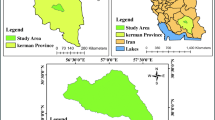Abstract
This work deals with the topic of qualification and prioritization of environmental impact in abandoned mining sites using fuzzy logic. It aims to classify old mining sites and describe their environmental impact through a numeric index. This is variable in the interval [0,1], and was named as index of environmental impact (I EI). Its determination was made through a fuzzy inference system that allows the integration of several characterization components. The system was supported by data obtained in five sites in NW Portugal, which is a paradigmatic region regarding the variety of typical environmental problems provoked by old metallic mines. These sites may be considered environmental patterns as they represent such regional diversity. In a general way, the I EI can be applied to other sites where the existence of abandoned mining structures generates environmental impact.












Similar content being viewed by others
References
Aroba, J., Grande, J. A., Andújar, J. M., de la Torre, M. L., & Riquelme, J. C. (2007). Application of fuzzy logic and data mining as tools for qualitative interpretation of acid mine processes. Environmental Geology, 53, 135–145.
De Siqueira, A., & De Mello, R. (2006). A decision support method for environmental impact assessment using a fuzzy logic approach. Ecological Economics, 58, 170–181.
Demicco, V., & Klir, J. (2004). Fuzzy logic in geology (p. 347). San Diego: Elsevier Academic Press.
Dumitras, A., & Moschytz, G. (2007). Understanding fuzzy logic: An interview with Lotfi Zadeh [DSP History]. Signal Processing Magazine, IEEE, 24, 102–105.
Fang, J. H. (1997). Fuzzy logic and geology. Geotimes, 42, 23–26.
Fang, J. H., & Chen, H. C. (1990). Uncertainties are better handled by fuzzy arithmetic. American Association of Petroleum Geologists Bulletin, 74, 1228–1233.
Grande, J. A., Andújar, J. M., Aroba, J., Beltrán, R., de la Torre, M. L., Cerón, R. C., et al. (2010a). Quantification of heavy metals from A.M.D. discharged into a Public Water Supply Dam in the Iberian Pyrite Belt (SW Spain) using centered moving average. Water, Air, and Soil Pollution. doi:10.1007/s11270-010-0343-y. online.
Grande, J. A., Jiménez, A., Romero, S., de la Torre, M. L., & Gómez, T. (2010b). Fuzzy modeling of the spatial evolution of the chemistry in the Tinto River (SW Spain). Water Resources Management. doi:10.1007/s11269-010-9603-2. online.
Gray, N. F. (1996). A substrate classification index for the visual assessment of the impact of acid mine drainage in lotic systems. Water Resources, 30, 1551–1554.
Gray, N. F. (1998). Acid mine drainage composition and the implications for its impact on lotic systems. Water Resources, 32, 2122–2134.
Jang, R., Sun, T., & Mizutani, E. (1997). Neuro-fuzzy and soft computing (p. 614). Upper Saddle River: Matlab Curriculum Series, Prentice-Hall.
Jarvis, A., & Younger, P. (2000). Broadening the scope of mine water environmental impact assessment: A UK perspective. Environmental Impact Assessment Review, 20, 85–96.
Jiménez, A., Aroba, J., de la Torre, M. L., Andujar, J. M., & Grande, J. A. (2009). Model of behaviour of conductivity versus pH in A.M.D. water bases on fuzzy logic and data mining techniques. Journal of Hydroinformatics, 11, 147–153.
McKibben, A. A., & Barnes, H. L. (1986). Oxidation of pyrite in low temperature acidic solutions: Rate laws and surface textures. Geochimica et Cosmochim Acta, 50, 1509–1520.
Peche, R., & Rodríguez, E. (2009). Environmental impact assessment procedure: A new approach based on fuzzy logic. Environmental Impact Assessment Review, 29, 275–283.
Rimstidt, J. D., & Vaughan, D. J. (2003). Pyrite oxidation: A state-of-the-art assessment of the reaction mechanism. Geochimica et Cosmochima Acta, 67, 873–880.
Santos Oliveira, J. M., Farinha, J., Matos, J. X., Ávila, P. F., Rosa, C., Canto Machado, M. J., Daniel, F. S., & Machado Leite, M. R. (2002). Diagnóstico ambiental das principais áreas mineiras degradadas do país. Boletim de Minas, 39, nº2.
Shepard, R. B. (2005). Quantifying environmental impact assessments using fuzzy logic (p. 264). Berlin: Springer.
Valente, T. (2004). Modelos de caracterização de impacte ambiental para escombreiras reactivas—Equilíbrio e evolução de resíduos, phD. Thesis, Universidade do Minho.
Valente, T., & Leal Gomes, C. (2007). The role of two acidophilic algae as ecological indicators of acid mine drainage sites. Journal of Iberian Geology, 33, 147–158.
Valente, T. M., & Leal Gomes, C. (2009a). Fuzzy modelling of acid mine drainage environments using geochemical, ecological and mineralogical indicators. Environmental Geology, 57, 653–663.
Valente, T. M., & Leal Gomes, C. (2009b). Occurrence, properties and pollution potential of environmental minerals in acid mine drainage. The Science of the Total Environment, 407, 1135–1152.
Zadeh, L. A. (1965). Fuzzy sets. Information and Control, 83, 338–353.
Zadeh, L. A. (1973). Outline of a new approach to the analysis of complex systems and decision processes. IEEE Transaction Systems, Man, and Cybernetics, SMC-3, 28–44.
Acknowledgments
The authors thank the anonymous reviewers for the valuable comments and suggestions.
Author information
Authors and Affiliations
Corresponding author
Rights and permissions
About this article
Cite this article
Valente, T.M., Ferreira, M.J. & Gomes, C.L. Application of Fuzzy Logic to Qualify the Environmental Impact in Abandoned Mining Sites. Water Air Soil Pollut 217, 303–315 (2011). https://doi.org/10.1007/s11270-010-0587-6
Received:
Accepted:
Published:
Issue Date:
DOI: https://doi.org/10.1007/s11270-010-0587-6




